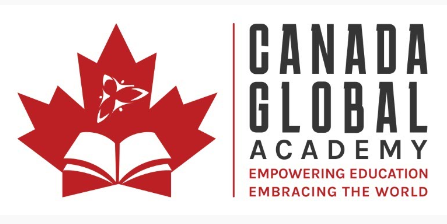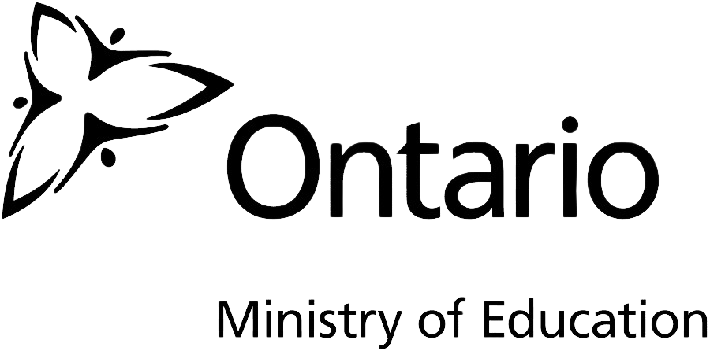Are our students prepared to thrive in a globally interconnected world? How do we cultivate their understanding of different cultures and foster a sense of global citizenship? The answer lies in innovative educational projects that empower students to become open-minded, culturally aware global citizens. In this article, we will explore four creative projects that are revolutionizing education and fostering intercultural understanding.
Key Takeaways:
- Global citizens are individuals who possess intercultural understanding.
- Educational expertise plays a crucial role in nurturing global citizenship.
- Creative projects can effectively promote intercultural sensitivity.
- Empowering students as leaders and teachers enhances cultural exchange.
- Incorporating global stories into the curriculum fosters intercultural understanding.
The Importance of Global Competence in Education
In today’s rapidly changing world, global competence plays a crucial role in education. According to the OECD PISA global competence framework, individuals need to possess the necessary skills to navigate intercultural issues and understand different perspectives. By developing global competence, students can effectively engage with the world around them and become successful in diverse societies.
Global competence goes beyond traditional academic knowledge. It encompasses the ability to examine local and global issues, appreciate diverse cultures, and take responsible action. By fostering global competence in education, schools can empower students to become open-minded global citizens who can make a positive impact on society.
Examining Local, Global, and Intercultural Issues
Global competence requires students to critically analyze complex issues that have both local and global dimensions. By studying these issues, students develop a deeper understanding of the interconnectedness of our world and recognize the impact of their actions. Whether it’s exploring the challenges of climate change or understanding the dynamics of social inequality, examining these issues equips students with the knowledge and skills needed to become agents of change.
Understanding Different Perspectives
One of the key components of global competence is the ability to understand different perspectives. By exposing students to diverse viewpoints, cultures, and histories, educators can foster empathy, respect, and appreciation for cultural differences. This understanding helps students break down stereotypes, challenge biases, and build bridges of understanding across cultures.
Taking Responsible Action
Global competence also involves taking responsible action in response to global challenges. Students must learn to recognize their role as global citizens and understand the consequences of their actions. By encouraging students to find innovative solutions and make socially responsible decisions, educators can empower them to contribute positively to their communities, both locally and globally.
“Global competence equips students with the knowledge, skills, and mindset necessary to navigate an interconnected world and become active participants in shaping a better future.”
Assessing global competence in education plays a vital role in promoting intercultural sensitivity and preparing students for a diverse society. Cognitive assessment helps schools evaluate students’ understanding and application of global competence skills. By identifying areas for improvement, educators can tailor their teaching strategies and provide targeted support to ensure students develop the necessary skills to thrive in a globalized world.
A Table on the Components of Global Competence
| Components of Global Competence | Description |
|---|---|
| Examining Local, Global, and Intercultural Issues | Analyzing complex issues with local and global dimensions to develop a deeper understanding of global challenges. |
| Understanding Different Perspectives | Recognizing and appreciating diverse viewpoints, cultures, and histories to foster empathy and respect. |
| Taking Responsible Action | Developing the ability to make socially responsible decisions and actively contribute to positive global change. |
Global competence is an essential skill set that equips students with the knowledge, skills, and mindset necessary to navigate an interconnected world and become active participants in shaping a better future. Through comprehensive cognitive assessment and a curriculum that prioritizes intercultural understanding, schools can nurture global competence in students and prepare them to thrive in an increasingly diverse and globalized society.
Global Citizenship Education: Nurturing Responsible Global Citizens

Global Citizenship Education (GCED) plays a crucial role in shaping the next generation of responsible global citizens. It goes beyond traditional academic subjects and emphasizes values such as respect for human rights, social justice, diversity, and environmental sustainability. Through innovative teaching methods and engaging activities, educators can instill these principles and empower students to become leaders who make a positive impact on the world.
One effective way to nurture global citizenship is by empowering students to take on leadership roles and become teachers themselves. By giving them opportunities to lead projects, present their ideas, and collaborate with their peers, students develop the skills and confidence needed to address real-world issues and promote positive change.
A key component of GCED is incorporating global stories into the curriculum. By introducing diverse perspectives through literature, students gain a deeper understanding of different cultures, experiences, and historical contexts. This fosters empathy, critical thinking skills, and intercultural understanding, enabling students to navigate complex global challenges with compassion and open-mindedness.
“GCED instills respect for human rights, social justice, diversity, and environmental sustainability.”
To further enhance global citizenship education, educators can organize penpal exchanges and field trips. Penpals allow students to communicate and build connections with peers from different cultural backgrounds, fostering empathy, cultural exchange, and understanding. Field trips provide firsthand experiences that expose students to diverse communities, environments, and perspectives, helping them appreciate the interconnectedness of our world.
Incorporating GCED into classrooms not only prepares students to be responsible global citizens but also equips them with essential skills for success in the 21st century. It promotes critical thinking, empathy, cultural competency, and the ability to navigate complex global challenges. By nurturing global citizenship education, educators play a vital role in creating a more inclusive, just, and sustainable world for all.
Empowering Students as Leaders and Teachers
Empowering students as leaders and teachers is a powerful way to foster cultural exchange, promote global perspectives, and celebrate the diversity within the classroom. By giving students the platform to share their own cultures, stories, songs, and languages, educators can create an inclusive environment that nurtures global awareness and intercultural understanding.
This approach not only allows students to showcase their unique backgrounds but also creates opportunities for them to teach, listen, and learn from their peers. When students take on leadership roles, they not only gain confidence and develop essential skills but also become ambassadors of their cultures, breaking down barriers and strengthening connections with others.
Through student-led initiatives, such as cultural showcases, language exchange programs, or collaborative projects, students can actively engage with different perspectives and expand their understanding of the world. This firsthand experience of cultural exchange sparks curiosity, empathy, and respect, nurturing global citizenship among students.
Fostering Global Perspectives Through Student Leadership
“The best way to teach global perspectives is through the students themselves. By empowering them to become leaders and teachers, we create a rich learning environment that celebrates diversity and prepares students for the interconnected world.” – Jane Williams, Educator
“In my classroom, I encourage students to take charge of their learning and share their unique experiences with the class. These student-led initiatives help create a sense of belonging and foster a deep appreciation for cultural diversity. It’s remarkable to witness how these opportunities empower students and inspire them to make a positive impact on the world.”
By providing students with the tools, resources, and support they need to become leaders and teachers, educators can ignite a passion for global understanding. This not only enriches the learning experience but also equips students with the necessary skills to thrive in an increasingly interconnected and diverse world.
Benefits of Empowering Students
- Promotes cultural exchange and understanding
- Enhances global awareness and sensitivity
- Fosters empathy, respect, and appreciation for diversity
- Develops leadership skills and confidence
- Prepares students for the challenges of a globalized society
Through student leadership, teaching, and cultural exchange, educators can nurture global perspectives and create a brighter future for all.
Incorporating Global Stories into the Curriculum
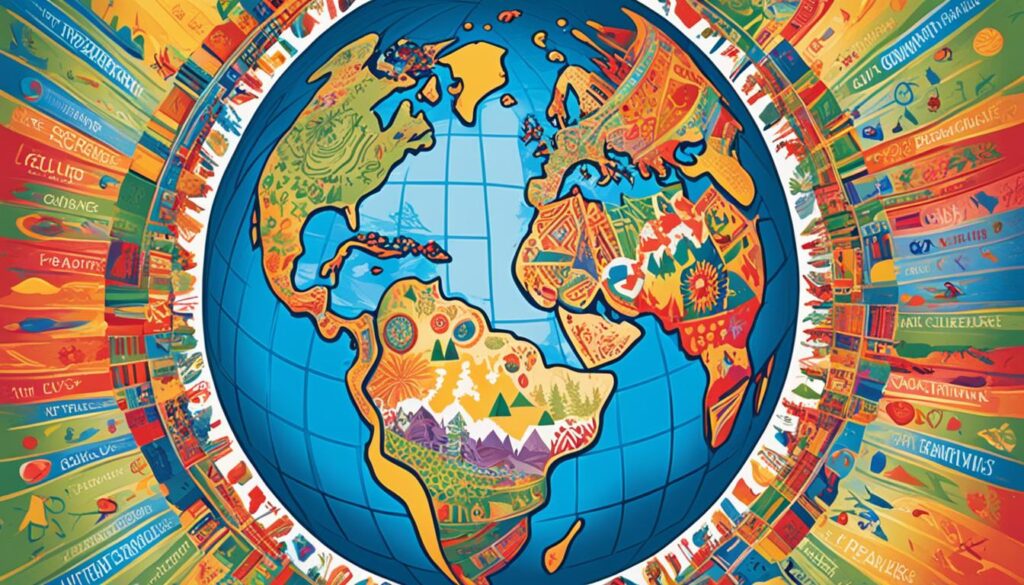
Integrating global stories into the curriculum is a powerful way to introduce students to different cultures and perspectives. By choosing literature that provides global perspectives, educators can help students understand the importance of experiencing other traditions and celebrating diversity.
Books like “What Does It Mean to Be Global?” and “The Kite Runner” can open students’ minds to new possibilities and foster intercultural understanding. These stories allow students to explore the complexities of cultural diversity and develop empathy towards characters from different backgrounds.
“Books are the mirrors through which students can see themselves and others. By incorporating global stories into the curriculum, educators can create a culturally responsive learning environment that promotes intercultural understanding and empathy.”
Through these stories, students can develop a deeper appreciation for the interconnectedness of our world and gain a broader perspective on global issues. By analyzing the characters’ experiences and reflecting on their own cultural identities, students can cultivate a sense of intercultural understanding and foster respect for diversity.
Fostering Critical Thinking and Cultural Awareness
Incorporating global stories into the curriculum also provides an opportunity for students to develop critical thinking skills. By examining different cultural perspectives portrayed in literature, students can analyze biases, challenge stereotypes, and engage in meaningful discussions about cultural diversity.
As students immerse themselves in stories from various regions and backgrounds, they can discover shared human experiences, common values, and universal emotions. This exploration of global stories not only enhances their cultural awareness but also encourages them to critically reflect on their own preconceptions and biases.
Through literary analysis and guided discussions, educators can nurture students’ ability to think critically, empathize with diverse characters, and navigate complex intercultural situations. This promotes a deeper understanding of global issues and fosters the development of well-rounded, culturally sensitive global citizens.
By incorporating global stories into the curriculum, educators equip students with the necessary tools to navigate an increasingly interconnected world. These stories serve as windows into different cultures and invite students to explore the richness of global diversity, fostering intercultural understanding and promoting a more inclusive society.
Building Connections through Penpals
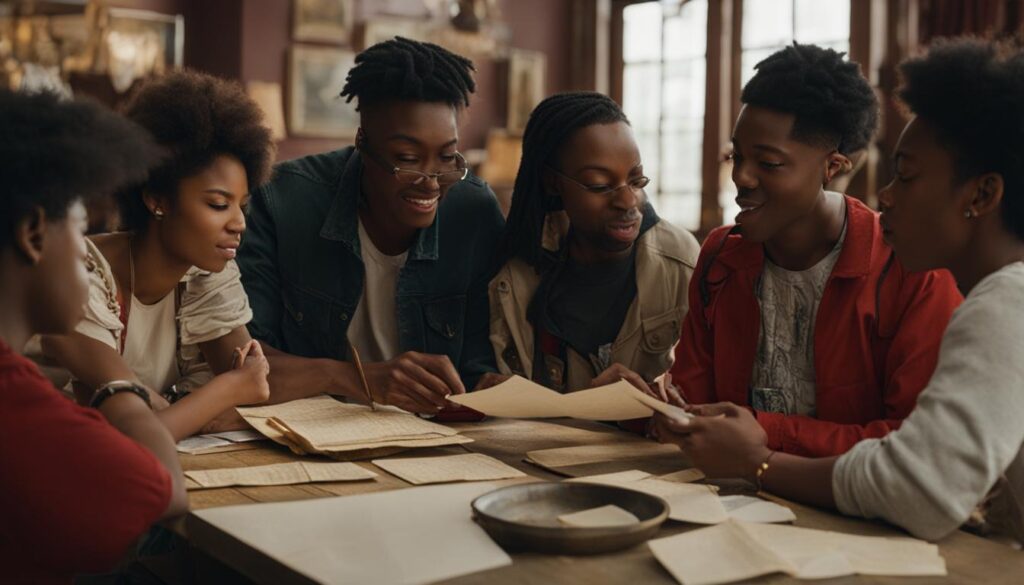
Connecting students with penpals from different cultures can facilitate meaningful communication and foster empathy and understanding. One-on-one communication with peers from other cultures allows students to develop compassion and gain a deeper appreciation for different values and perspectives.
Penpal exchanges encourage students to reflect on their own cultural identities and build connections with others around the world.
Benefits of Penpal Exchanges
“By communicating with penpals from diverse backgrounds, students learn to embrace cultural differences and develop a sense of global citizenship. They gain insights into other cultures, traditions, and perspectives, fostering empathy and understanding.”
Through penpal exchanges, students have the opportunity to ask questions, share personal experiences, and engage in meaningful conversations. This direct interaction helps break down stereotypes and promotes intercultural learning.
Penpals provide a unique perspective on the world, allowing students to explore different customs, languages, and ways of life. This fosters a sense of curiosity and promotes cross-cultural understanding.
Sample Penpal Exchange Program
Canada Global Academy’s School Partnership Program offers an exemplary penpal exchange program that connects students from across the globe. Through this program, students have the opportunity to build connections and engage in rich cultural exchanges.
| Features | Benefits |
|---|---|
| One-on-one communication | Develop empathy and understanding |
| Cultural exchange activities | Expand global knowledge |
| Collaborative projects | Promote teamwork and mutual respect |
| Virtual field trips | Explore different cultures and traditions |
Engaging in a penpal exchange program provides an invaluable opportunity for students to develop intercultural communication skills and cultivate a broader worldview.
Don’t miss the chance to participate in transformative penpal exchanges that promote cultural exchange, communication, empathy, and understanding. Join Canada Global Academy’s School Partnership Program today and unlock the world through meaningful connections.
Grants and Travel Opportunities for Global Learning

Are you an educator seeking to enhance your students’ global learning experience? Look no further than the Fulbright grant, a prestigious opportunity that allows you to immerse yourself in different cultures and bring powerful educational resources back to your classroom. Through this grant, you can embark on a transformative journey where you will discover new perspectives, explore diverse traditions, and gain valuable insights into educational practices from around the world.
Traveling to other countries as part of the Fulbright program offers a unique chance to engage in cultural immersion and develop a deeper understanding of global citizenship. By experiencing firsthand the customs, languages, and values of different societies, you can enrich your teaching with authentic and captivating educational resources.
Integrating these global experiences into your classroom will enable you to provide your students with a broader perspective on the world. By sharing stories, artifacts, and knowledge gained during your travel, you can ignite their curiosity, spark meaningful discussions, and foster a sense of intercultural understanding.
Moreover, the Fulbright grant offers you the opportunity to establish connections and collaborate with educators from diverse backgrounds. Through these partnerships, you can exchange pedagogical strategies, engage in dialogue about best practices in global learning, and expand your educational network.
Don’t miss out on this incredible opportunity to transform your teaching and inspire your students to become global citizens. Apply for the Fulbright grant and open doors to endless possibilities for educational growth and cultural immersion.
“The Fulbright grant is a life-changing experience that empowers educators to bring the world into their classrooms and inspire the next generation of global citizens.” – [Author Name]
| Benefits of the Fulbright Grant | Requirements | Application Process |
|---|---|---|
|
|
|
Virtual Field Trips for Global Learning

In today’s digital age, educational technology has opened up new opportunities for students to explore the world without leaving the classroom. Virtual field trips have become a popular tool for fostering global awareness and understanding, allowing students to embark on virtual tours of museums and cultural sites from around the world.
One of the notable platforms offering virtual tours is the Louvre, providing students with an immersive experience of iconic artworks and historical artifacts. Through detailed images and interactive features, students can gain a deeper understanding of different cultures and art styles.
Another valuable resource is the Google Art Project, which offers virtual tours of museums and collections globally. Students can navigate through various exhibits, explore artwork from different time periods, and discover the rich diversity of global artistry.
These virtual field trips not only provide access to renowned museums and cultural institutions but also offer students the chance to develop a global perspective. By virtually exploring different cultures, students can broaden their horizons, enhance their intercultural understanding, and cultivate empathy for people from diverse backgrounds.
Through virtual field trips, educational technology is revolutionizing traditional learning methods by bringing global experiences directly to students’ fingertips. This innovative approach to learning not only supplements classroom teachings but also immerses students in interactive and engaging experiences that foster curiosity and critical thinking.
By incorporating virtual field trips into the curriculum, educators can spark students’ interest in different cultures, encourage them to ask meaningful questions, and inspire them to explore the world beyond their immediate surroundings. These experiences can lay the foundation for nurturing global citizens who are curious, open-minded, and equipped with the intercultural competence needed to thrive in a globally interconnected society.
Table: Comparison of Virtual Tour Platforms
| Platform | Features | Accessibility | User Experience |
|---|---|---|---|
| Louvre | Immersive visual experience, interactive features | Free virtual tours, available from anywhere with internet access | User-friendly interface, high-quality images |
| Google Art Project | Virtual tours of museums and galleries worldwide | Free access to virtual exhibits, compatible with various devices | Easy navigation, extensive art collections |
Embarking on virtual field trips not only expands students’ cultural horizons but also enhances their understanding of global perspectives, fosters intercultural understanding, and prepares them for the challenges of the 21st century. Educational technology has bridged the gap between classrooms and the world, empowering students to become global citizens with a broadened worldview.
Connecting Classroom Learning to Real-World Issues

Engaging students in discussions about current events and global issues is crucial for fostering critical thinking and a sense of responsibility as global citizens. By connecting classroom learning to the real world, educators can help students understand the global impact of various challenges and encourage empathy towards others.
One effective approach is to incorporate news articles, documentaries, or podcasts into the curriculum that highlight global issues. This allows students to explore different perspectives, analyze complex situations, and develop critical thinking skills. By actively discussing these topics in the classroom, educators can create a space for students to voice their thoughts, consider multiple viewpoints, and engage in thoughtful dialogue.
“Education is the most powerful weapon which you can use to change the world.” – Nelson Mandela
Encouraging students to engage with current events also helps them see the relevance of their learning beyond the classroom walls. By discussing real-world issues, students can better grasp the interconnections between different regions, cultures, and societies. This broader perspective fosters a sense of global citizenship and motivates students to take action to address pressing global challenges.
By weaving current events into daily lessons and encouraging critical analysis, educators can help students become active participants in shaping our global future.
To illustrate the impact of connecting classroom learning to real-world issues, consider the following example:
| Example: | A geography class studying the effects of climate change on coastal communities integrates current news articles and videos about communities impacted by rising sea levels. Students engage in discussions, analyze data, and explore potential solutions. This hands-on approach helps them understand the real-world implications of climate change and its widespread effects. |
|---|
Promoting Volunteerism in the Community

Volunteering within the local community is a powerful way to instill the values of global citizenship and civic engagement in students. By actively participating in community service projects that address local challenges, students develop a sense of responsibility for their communities and the wider world.
Through community service, students have the opportunity to make a social impact and contribute to positive change. Engaging in hands-on service projects teaches them valuable lessons about compassion, empathy, and the importance of taking action to create a better world.
“Service to others is the rent you pay for your room here on earth.” – Muhammad Ali
By volunteering, students gain a deeper understanding of the social issues that affect their communities and develop a sense of empathy towards those in need. They learn to appreciate the interconnectedness of global challenges and recognize their role as global citizens in addressing these issues.
Moreover, community service provides students with the opportunity to engage with individuals from diverse backgrounds and cultures. This fosters intercultural understanding and helps students develop a broader perspective on the world.
Through service projects, students can also develop essential skills such as teamwork, leadership, and problem-solving. They learn to collaborate with others to achieve common goals and find innovative solutions to community challenges.
Additionally, volunteering in the community allows students to apply their academic knowledge in real-life situations. They can see the practical implications of what they learn in the classroom and gain a deeper appreciation for the relevance of their education in making a positive impact on society.
As students actively engage in community service, they become agents of change, exemplifying the principles of global citizenship and inspiring others to get involved. Their actions have a ripple effect, creating a culture of civic engagement and social responsibility within their communities.
It’s time to empower students to make a difference in their communities and the world. Encourage them to get involved in community service and experience the transformative power of volunteerism.
Visit the Canada Global Academy’s School Partnership Program to learn more about how schools can revolutionize education and promote global citizenship through innovative programs and partnerships.
Conclusion
Fostering global citizenship and promoting intercultural understanding is paramount in today’s interconnected world. It is through educational expertise and creative projects that educators have the power to empower students to become compassionate and culturally aware global citizens. By incorporating global perspectives into the curriculum, providing opportunities for cultural exchange and communication, and promoting engagement with global issues, educators are nurturing the next generation of global leaders.
As we have explored in this article, global citizens are individuals who possess a deep understanding and appreciation of diverse cultures, values, and perspectives. Through educational expertise, educators can equip students with the knowledge and skills necessary to navigate the complexities of our interconnected world with empathy and respect.
To further support educators in this endeavor, organizations like Canada Global Academy offer innovative programs such as the School Partnership Program. This program revolutionizes schools by providing valuable resources and support for fostering intercultural understanding and global citizenship. To learn more about Canada Global Academy’s School Partnership Program, visit https://canadaglobalacademy.com/school-partnership-program/.
Let us embrace our role as global citizens and work together to create a more inclusive, empathetic, and interconnected world. By nurturing intercultural understanding and fostering global citizenship in our classrooms, we are sowing the seeds of a brighter future for generations to come.
FAQ
What is global citizenship?
Global citizenship refers to the idea of individuals recognizing themselves as part of a global community, with a sense of responsibility towards the world and its diverse cultures and issues.
How does global competence benefit students?
Global competence equips students with the skills and knowledge to navigate diverse societies, understand different perspectives, and take responsible action in a rapidly changing world.
How can educators promote global citizenship in the classroom?
Educators can promote global citizenship by empowering students as leaders and teachers, integrating global stories into the curriculum, connecting students with penpals from different cultures, and engaging students in discussions about global issues.
What are the benefits of empowering students as leaders and teachers?
Empowering students as leaders and teachers allows for cultural exchange, creates opportunities for students to share their own perspectives and stories, and fosters a classroom environment that celebrates diversity and fosters global awareness.
How can educators incorporate global stories into the curriculum?
Educators can incorporate global stories into the curriculum by selecting literature that provides global perspectives, introducing students to different cultures and traditions, and encouraging an understanding and celebration of diversity.
How can penpals foster intercultural understanding?
Penpals from different cultures allow students to engage in meaningful communication, develop empathy and understanding for different values and perspectives, reflect on their own cultural identities, and build connections with others around the world.
Are there grants available for educators to travel and bring global experiences to the classroom?
Yes, educators can apply for grants such as the Fulbright grant, which provides the opportunity to travel to other countries, learn about different cultures and educational practices, and integrate these experiences into their teaching to enhance students’ global perspective.
How can virtual field trips contribute to global learning?
Virtual field trips allow students to explore museums, collections, and historical sites from around the world, providing them with the opportunity to learn about different cultures and foster global awareness and understanding without leaving the classroom.
Why is connecting classroom learning to real-world issues important?
Connecting classroom learning to real-world issues helps students understand that global challenges affect people worldwide, fostering empathy and encouraging critical thinking about global issues. This promotes a sense of responsibility and active engagement as global citizens.
How can volunteerism in the community promote global citizenship?
Engaging students in service projects that address local challenges helps them develop a sense of responsibility for their communities and the wider world. Actively contributing to social impact initiatives teaches valuable lessons about compassion, empathy, and the importance of taking action to create positive change.
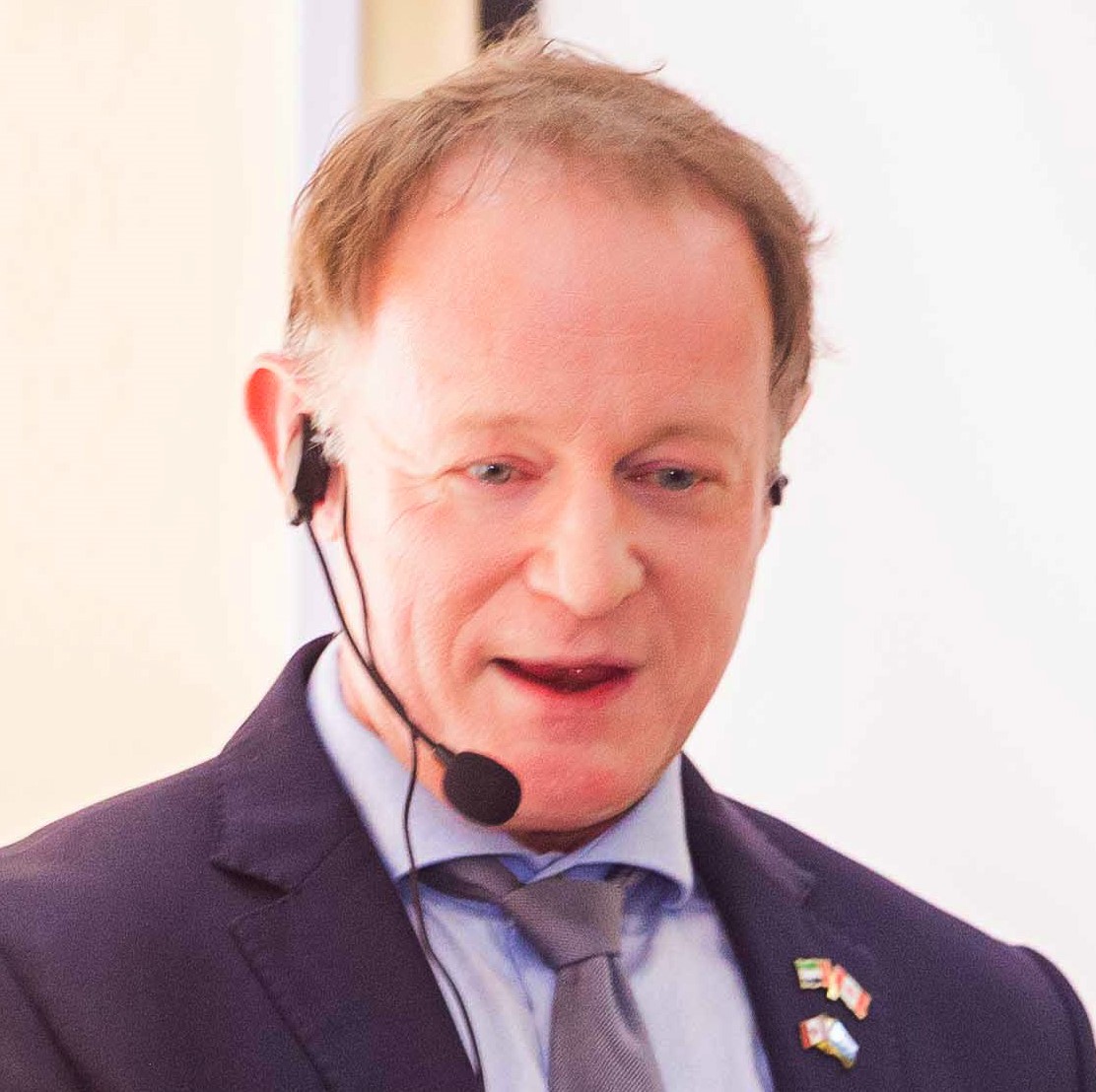
Martin Doherty is the CEO of Ethos Education & Canadian Global Academy : the exclusive authorized provider of the renowned 3rd globally ranked Ontario Ministry of Education‘s curriculum and Digital Learning Platform outside of Canada. He is also the founder the cutting edge magazine, Education Distruptor.
Through our School Partnership Program, we empower schools worldwide to attain Canadian Accreditation, providing the opportunity to establish themselves as Canadian Accredited schools. Additionally, home-based businesses can run their own Canadian Accredited Micro-School. Contact us today to learn more!
Related Posts
- Augmented Reality Adventures: Engaging Students with Immersive Global Learning
Elevate education with school technology & innovation – dive into AR learning that inspires and…
- Social-Emotional Learning Spotlight: Building Well-Rounded Global Citizens
Unlock educational expertise to cultivate social-emotional skills essential for nurturing well-rounded global citizens. Join us…
